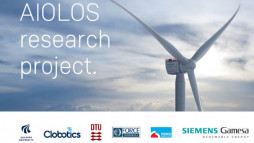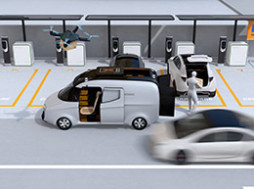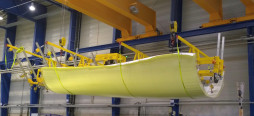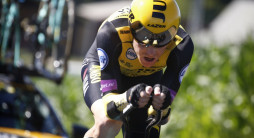
Consortium kicks off research project for blade production optimization
The future demand of wind power requires a steep ramp-up of large component production to the offshore wind industry. Danish consortium has kicked-off the research project, AIOLOS, which aims to optimize factory output at low cost.
Due to the large demand for offshore wind in the future, component production, including the blades, needs to increase significantly. Furthermore, it is important to limit the need for costly new factories to ensure competitiveness. Consequently, new innovative development in automatization and digitalization seem to be an appropriate solution that can easily be implemented in already existing production facilities.
This starting point has resulted in the establishment of the AIOLOS research project, which was kicked off in April 2021 and will run until 2024. Innovation Fund Denmark has invested 38.4 million DKK in the project.
The research project represents a paradigm-shift when it comes to addressing blade production and factory output. It will tackle the most important cost drivers in the production of large high-performance composite structures (>15m length) and aims to develop ways to increase production capability, flexibility and quality.
The AIOLOS project aspires to:
- Significantly decrease both operational as well as capital expenditures (OPEX and CAPEX)
- Significantly increase factory output through acceleration, automation and digitalization
- Decrease production waste
- Reduce non-conformance of large composite structure production
Made in Denmark AIOLOS will be implemented at Siemens Gamesa’s factory in Aalborg, Denmark. Here specifically, it is expected to significantly increase the company’s blade production as well as enable a reduction of blade manufacturing costs.
Across the entire wind industry in Denmark, it is also expected that AIOLOS will increase job opportunities in areas such as robot operation and maintenance, data analysis and blade production operators.
The technologies developed in the framework of this project will be adapted for a wider industrial spectrum including maritime and transport industries.
AIOLOS is led by Siemens Gamesa Renewable Energy, and comprises six consortium partners from both industry and academia:
- ·Siemens Gamesa Renewable Energy: Wind turbine manufacturer ensuring that the development impact in AIOLOS can be maximized for large OEMs
- Clobotics and Pontis: Innovative SMEs providing specialized key knowledge for production improvements, and who will drive the wider applicability of AIOLOS’ results into the Danish wind industry
- FORCE Technology: A leading non-profit research company, which is a governmentally supported research hub to support industry and cross-industry collaboration
- Aalborg University: University which will focus its expertise on design of modular prefabricated blade components and the joining of those and support the dissemination and training level achieved by AIOLOS.
- DTU Wind Energy (Technical University of Denmark): University which will contribute with its expertise in modelling and manufacturing to establishing a digital factory with improved processes and product quality as well as to support the dissemination and training level achieved by AIOLOS.
Facts
- The total project budget is 77,650,000 DKK (approx. 10,420,000 €) and hereof, Innovation Fund Denmark is responsible for 38,380,000 DKK (approx. 5,150,000 €).
- The project will run from 2021 – 2024.

AMAC and Pontis Engineering join forces
Pontis Engineering and AMAC join forces in bringing next level composite solutions to the e-mobility sector
Pontis is pleased to announce its cooperation with AMAC GmbH as of March 1st, 2021. This collaboration focuses on the business development of medium volume niche applications in e-mobility based on advanced composites. The applications range from the development of lightweight over structural battery housings to complete electric vehicles for road, industry, water and air transportation.
Pontis Engineering is an innovative, international engineering company, specialized in one-stop-shop engineering solutions for advanced composite niche applications. The company is renowned for its state-of-the-art, precise and sustainable composite solutions for leading customers across industries including aerospace, wind energy and mobility. Pontis´ developments include the world's largest rotor blades (100+ meters), the new Olympic track bike and solar panels for weather satellites.
AMAC and Pontis aim to support the fast-growing e-mobility market with high-end, lightweight and energy-saving composite solutions in order to make a valuable contribution to global mobility and sustainability challenges.
Statements
Sjef van Breugel, Managing Director of Pontis Engineering: “We are ready to bring our 25+ year track record of cutting-edge technology to the dynamic, innovative and sustainable e-mobility sector at full speed. We have strong assets to enable and support the rapid growth of this sector with the best lightweight solutions. With our extensive experience in disruptive engineering for renewable energies, our people, competences and development capacities, we are well positioned to advance the future of mobility.“
Dr. Michael Effing, Managing Director of AMAC: „The core competence of Pontis is to develop lightweight electrical passenger cars reducing the fuel consumption and bringing down CO2 emissions, from feasibility studies over industrial transportation to last-mile-delivery. Pontis differentiates, because they offer tailored cost-efficient solutions, based on a Design for Manufacturing approach. The global market for electrical vehicles is about 4 Mio units in 2020 and is expected to grow to more than 25 Mio EVs by 2030. The increasing adoption of electric buses is likely to propel the growth of commercial vehicles in this period even more. This is a huge opportunity for lightweight composites”.

How to maintain and develop your supply chain in a changing world?
Since travel is kept to a minimum these days, international supply chain management can be a headache. How to manage your critical overseas suppliers today (quality, control, optimization)? COVID-19 requires us to take a different approach.
We understand the importance of controlling every link of your supply chain. With over 15 years of experience and an extensive international network of offices (Europe, Asia and the USA) and partners (China and South America), we can service you anywhere in the world. We work with local experts on the ground, supported by our team of experts in Europe.
Maintain, develop or boost performance of your local composite supplier? Reach out to us: we help you stay competitive!

The Advantages of Preforming Technology in Rotor Blade Development
Preforms have been used in infusion moulding processes for the last 80 years, but most of them were made with chopped glass fibers directed over perforated metal forms. Recently, with the use of automated weaving and knitting machinery, we have engineered preforms that are increasingly capable of reinforcing structural composite parts to increase their performance. Today, preforms can be created in several seconds – faster than metal can be stamped. Preforms can save money and accelerate the production process.
Preforming technology enables manufacturers of composite rotor blades to reduce in-mould cycle times, as well as reduce cost and increase their output.
In the past few years, rotor blades have reached increasingly large dimensions. Blade lengths of more than 100 meters can be achieved using the combination of traditional glass fiber reinforced materials and carbon fiber - and the benefits of preforming technology in rotor blade development are more than obvious.
1. Automating the production of high-performance parts
Composite parts made from fiber and resin are highly sophisticated materials with a wide application range from automotive parts to aerospace. Fiber-reinforced composites offer a unique combination of low weight and high tensile strength, but also require sophisticated manufacturing procedures.
Rotor blade development requires creating complex preforms. Instead of relying on manual labour, we can now include robotics. As a result, minimized waste of fabrication materials, high output rates (in case of high production volumes), and software-optimized planning while lowering the risk of human error make the procedure economically interesting. Other automated solutions have demonstrated a cost reduction of approximately 10%.
2. Computer-assisted fabrication
Rotor blade manufacturers use specialized software for form planning which enables designing the rotor blade shapes as well as calculating the finished product’s mechanical properties (depending on which composites are used). Being able to plan, simulate, optimize, and preform based directly on this data helps manufacturers determine the best approach to preforming procedures. Also, it helps them minimize material and time required for the process.
3. Reduced in-mould cycle times
Preforming technology enables manufacturers of composite rotor blades to reduce in-mould cycle times, as well as reduce cost and increase their output. Production trials in rotor blade production, performed by Pontis, demonstrated a massive reduction of the in-mould cycle time (50%).
4. Preforming is a necessary step for ensuring quality
Reliability and quality are some of the most important challenges for the production of composite parts. Defects that may occur in the preforming stage can influence following process steps, lead to rejection of whole preforms, or result in damage of tools due to wrinkles and folds.
For example, creating composite parts as large as rotor blades involves many production steps. Preforming is the last and most necessary one when it comes to ensuring that the part meets the benchmark in terms of structural performance and lightweight potential. If done manually, this may lead to additional cost for material and labour, but Pontis’ preforming technology can reduce the material resources, effort, and time required for the development and production of composite rotor blades.
Pontis Engineering offers a complete, turn-key solution for your composite product needs. Our offer also includes all necessary hardware, training, and advice to help you optimize the entire production process. We have invented a simple, yet effective and unique tooling and moulding solution based on preforming – creating individual modules that can easily be joined into a composite structure of high durability and quality.
Pontis Engineering:
Official website

Historic results with Pontis’ time trial handle bar
We congratulate Team Jumbo-Visma with the historic achievements in both the Giro and the Tour de France! At Pontis we are also proud: in recent months, under initiative of Jumbo Supermarkten, team Jumbo-Visma and Full Speed Ahead, we developed the time trial handle bar for Primoz Roglic and Steven Kruijswijk. This handle bar ensures a faster bike through improved aerodynamics and lower weight. And with striking results! Primoz finished third in the Giro and won 2 time trials. And Steven achieved third place in the Tour de France on Sunday and won 1 time trial. Great performances that we enjoy as much as you do! Thank you for being part of this winning partnership!





